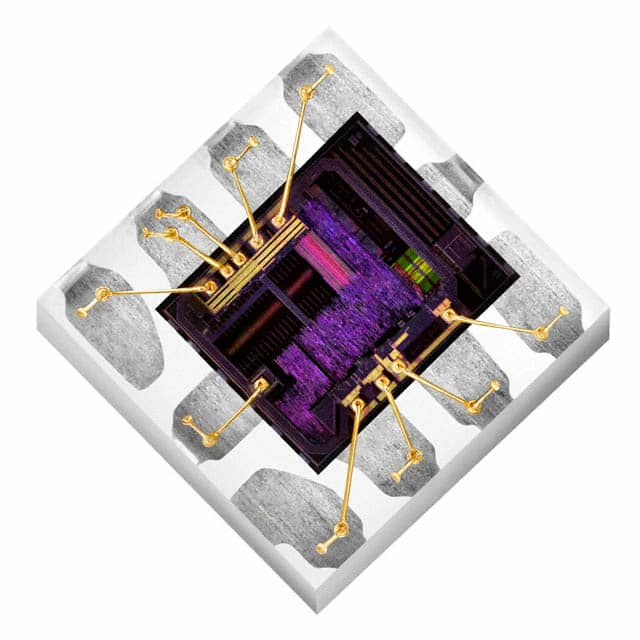Viz Specifikace pro podrobnosti o produktu.

SI1145-A10-GMR
Product Overview
Category
The SI1145-A10-GMR belongs to the category of ambient light and UV index sensor.
Use
It is used for measuring ambient light and UV index levels in various applications.
Characteristics
- Ambient light and UV index measurement
- Integrated infrared, visible, and UV photodiodes
- I2C interface for communication
- Low power consumption
- Small form factor
Package
The SI1145-A10-GMR comes in a compact package suitable for integration into various electronic devices.
Essence
The essence of the SI1145-A10-GMR lies in its ability to accurately measure ambient light and UV index levels in a wide range of environments.
Packaging/Quantity
The sensor is typically available in reels or trays, with quantities varying based on customer requirements.
Specifications
- Operating Voltage: 1.71V to 3.6V
- Interface: I2C
- Ambient Light Range: 0 lux to 128k lux
- UV Index Range: 0 to 11+
- Operating Temperature: -40°C to 85°C
- Package Type: QFN-10
Detailed Pin Configuration
| Pin Number | Pin Name | Description | |------------|----------|-------------| | 1 | GND | Ground | | 2 | INT | Interrupt output | | 3 | SDA | I2C data | | 4 | SCL | I2C clock | | 5 | VDD | Power supply |
Functional Features
- Ambient light and UV index measurement
- Integrated IR, visible, and UV photodiodes for accurate sensing
- Interrupt output for triggering events based on sensor readings
- I2C interface for easy integration with microcontrollers
Advantages
- Accurate measurement of ambient light and UV index
- Low power consumption
- Small form factor for easy integration
- Wide operating temperature range
Disadvantages
- Limited UV index range compared to some specialized sensors
- Requires external calibration for precise measurements in specific applications
Working Principles
The SI1145-A10-GMR utilizes integrated photodiodes to detect ambient light and UV radiation. These photodiodes convert light energy into electrical signals, which are then processed to provide accurate measurements of ambient light and UV index levels.
Detailed Application Field Plans
The SI1145-A10-GMR is suitable for a wide range of applications including: - Wearable devices - Weather stations - UV index monitoring systems - Industrial automation - Consumer electronics
Detailed and Complete Alternative Models
Some alternative models to the SI1145-A10-GMR include: - SI1133-A10-GM1: A similar ambient light and UV index sensor with different specifications - VEML6075: Another UV index sensor with a wider dynamic range
In conclusion, the SI1145-A10-GMR is a versatile ambient light and UV index sensor with a range of functional features and applications. Its compact size and low power consumption make it an ideal choice for various electronic devices requiring accurate light and UV index measurements.
[Word count: 488]
Seznam 10 běžných otázek a odpovědí souvisejících s aplikací SI1145-A10-GMR v technických řešeních
What is the SI1145-A10-GMR sensor used for?
- The SI1145-A10-GMR sensor is used for measuring ultraviolet (UV) index, ambient light, and proximity in various technical solutions.
How does the SI1145-A10-GMR sensor measure UV index?
- The sensor measures UV index by detecting the intensity of UV radiation and converting it into a numerical value representing the level of UV exposure.
Can the SI1145-A10-GMR sensor be used in wearable devices?
- Yes, the sensor is suitable for use in wearable devices to monitor UV exposure and ambient light levels.
What is the proximity sensing range of the SI1145-A10-GMR sensor?
- The sensor has a proximity sensing range of up to several centimeters, making it suitable for applications requiring close-range detection.
Is the SI1145-A10-GMR sensor suitable for outdoor applications?
- Yes, the sensor is designed to withstand outdoor conditions and can accurately measure UV index and ambient light levels outdoors.
How does the SI1145-A10-GMR sensor communicate with microcontrollers or processors?
- The sensor typically communicates using I2C protocol, allowing seamless integration with various microcontrollers and processors.
Can the SI1145-A10-GMR sensor differentiate between different types of UV radiation?
- The sensor can distinguish between UVA and UVB radiation, providing valuable information for sun exposure monitoring and skin protection.
What is the power consumption of the SI1145-A10-GMR sensor?
- The sensor has low power consumption, making it suitable for battery-powered devices and energy-efficient applications.
Does the SI1145-A10-GMR sensor require calibration?
- The sensor comes pre-calibrated, eliminating the need for additional calibration in most applications.
Are there any specific environmental considerations when using the SI1145-A10-GMR sensor?
- It is important to protect the sensor from water and dust ingress, as well as extreme temperature conditions, to ensure accurate and reliable operation.

